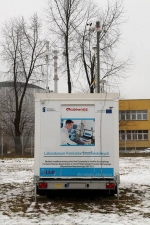Air in Świerk is clean
22-04-2015
Mobile environmental analyses lab was monitoring air in Świerk for two weeks in February 2015. The lab was deployed in the field between the MARIA reactor building and building occupied by NCBJ Department of Training and Education (visited annually by more than 7,000 visitors). Results of a series of precise measurements were logged. Analysis of the results showed that air in Świerk is clean.
We looked for air pollution potentially coming from such sources as national road No. 17 routed nearby, coal- or oil-fired ovens in houses of neighbourhood inhabitants, and/or reactor itself. – explains Dr. Jan Sernicki, Head of NCBJ Interdisciplinary Applications of Physics Division – However, the tests showed that air over the Świerk research centre is clean.
Measurements included immission of particulate matter in air. The PM10 and PM2.5 fractions were measured. The former was measured manually using a PNS3D15 sequential aspirator and the gravimetric method, as well as automatically using an Environment MP101M dust monitor. The latter was measured using another Environment MP101M dust monitor with a PM2.5 separation head. All measurements were conducted in line with the highest European Union standards (the 2008/50/WE Directive issued by European Parliament and European Council), as well as with national regulations (Polish Ministry of Environment regulation in the matter of evaluation of atmospheric air pollution issued on September 13, 2012).
There is no doubt: air over the Świerk research centre is clean. Our small research reactor is not polluting the atmosphere, just like large nuclear power plants are not. – points out Professor Grzegorz Wrochna, NCBJ Director General. – Nuclear power industry can deliver electricity without emitting anything into the atmosphere. Taking into account both growing demand for power and environment protection requirements (in particular a requirement to reduce particulate matter/NOx/sulphur emissions), one can easily see that nuclear reactors are well attending to our needs.
A capability to reliably evaluate air quality is becoming increasingly important, in particular in metropolitan areas most exposed to smog that makes hard life of inhabitants of such cities. Air quality impact is among evaluation criteria of any planned road development. A continuous air quality monitoring performed for a period as long as several years after the development is accomplished would be necessary to reliably conclude how efficient were the solutions applied to protect the environment.
Mobile environmental analyses lab developed in NCBJ is a dedicated air-conditioned container equipped with some state-of-the-art instruments that are capable to comprehensively analyse air quality. The equipment includes gauges commonly used by Voivodeship Inspectorates for Environmental Protection, modern analysers, gravimetric dust samplers, setups for measurements of gaseous air contaminants (including nitrogen oxides, carbon monoxide, ozone), and a weather station equipped with a 10-meter high mast to record weather conditions prevailing at the venue during measurements. The lab may be used to comprehensively analyse fractions in particulate matter suspended in the air. As one of a few labs in the country it is capable to identify particles of diameters even as small as 20 nanometres, i.e. two thousand times smaller than human hair. Advantages include a small footprint (slightly above 5.5 m2), lightweight compact housing, and capability of simple towing behind a passenger car. The lab may be used to have the air quality analysed in many distant places in a possibly short time.
Świerk scientists have already applied the lab to analyse quality of air at some road junctions in Warsaw. In collaboration with Green Mazovia Association and Światowid Ecology Association quality of air sampled at the S2 express road/Al. Krakowska street junction was precisely measured for a few weeks of October 2014, and a month later – at the Armii Krajowej Avenue (the Ruda housing estate).
Mobile environmental analyses lab has been developed in NCBJ Interdisciplinary Applications of Physics Division within the framework of the Development of Ionizing Radiation-Based Technologies in NCBJ Świerk (a.k.a. 4LABY) project. The 39.7 million PLN worth project was co-financed by European Union from the Regional Development European Fund within the framework of the Regional Operational Programme for Masovian Voivodeship 2007-2013, Priority I Creating conditions for development of innovation potential and entrepreneurship in Masovia, Measure 1.1 Strengthening the R&D sector. 2.2 million PLN have been assigned within framework of the 4LABY project to develop the mobile environmental analyses lab. The lab helped to strengthen collaborations with various entities, including Institute of Nuclear Chemistry and Technology in Warsaw, Warsaw University of Technology, the KAMIKA Instruments company.
NCBJ scientists have been looking for methods to more efficiently utilize multi-year databases and real-time information available in the country to forecast concentration of particulate matter in the air already for a couple of years. Besides, some Świerk-based teams (including the MANHAZ Centre of Excellence) work on propagation of various substances (including radioactive ones) through the environment. The large computational cluster operated by NCBJ CIS computer centre helps to study such topics.
***
With its over 1,000 employees, NCBJ is one of the largest research institutes in Poland. Its profile includes support for the nuclear power programme in Poland, pure research in sub-atomic physics (physics of elementary particles, nuclear physics, hot plasma physics etc.), practical applications of nuclear methods, manufacture of equipment for various branches of science and national economy, in particular for medicine. NCBJ operates MARIA, the sole nuclear reactor in Poland, used to produce radioactive isotopes, to radiation-modify various materials, and to conduct research with the use of neutron beams. NCBJ participates in many international research projects, especially on new nuclear-related technologies. Outcomes of research conducted in NCBJ will be implemented in the Świerk Science and Technology Park.
More info: rzecznik@ncbj.gov.pl





